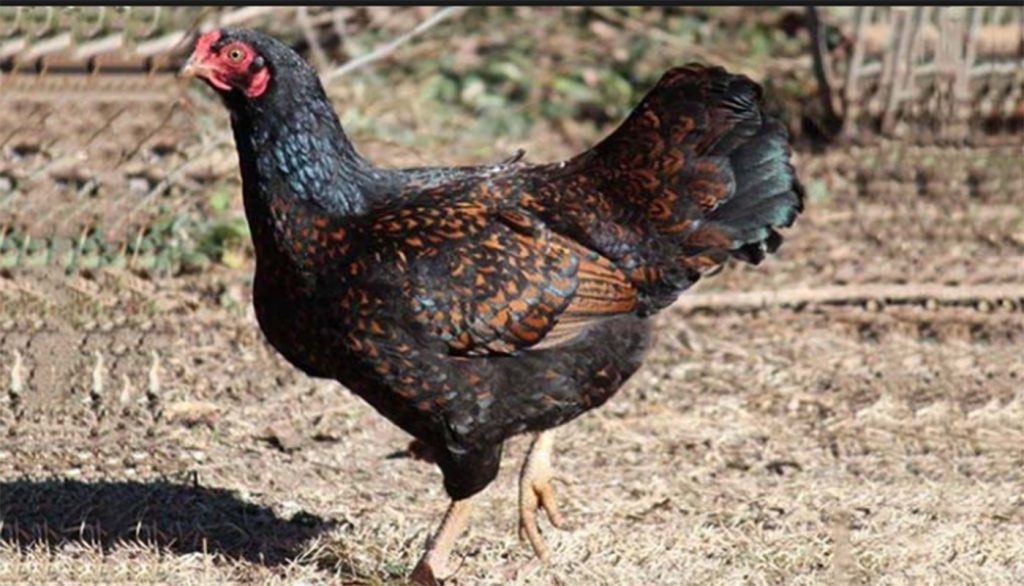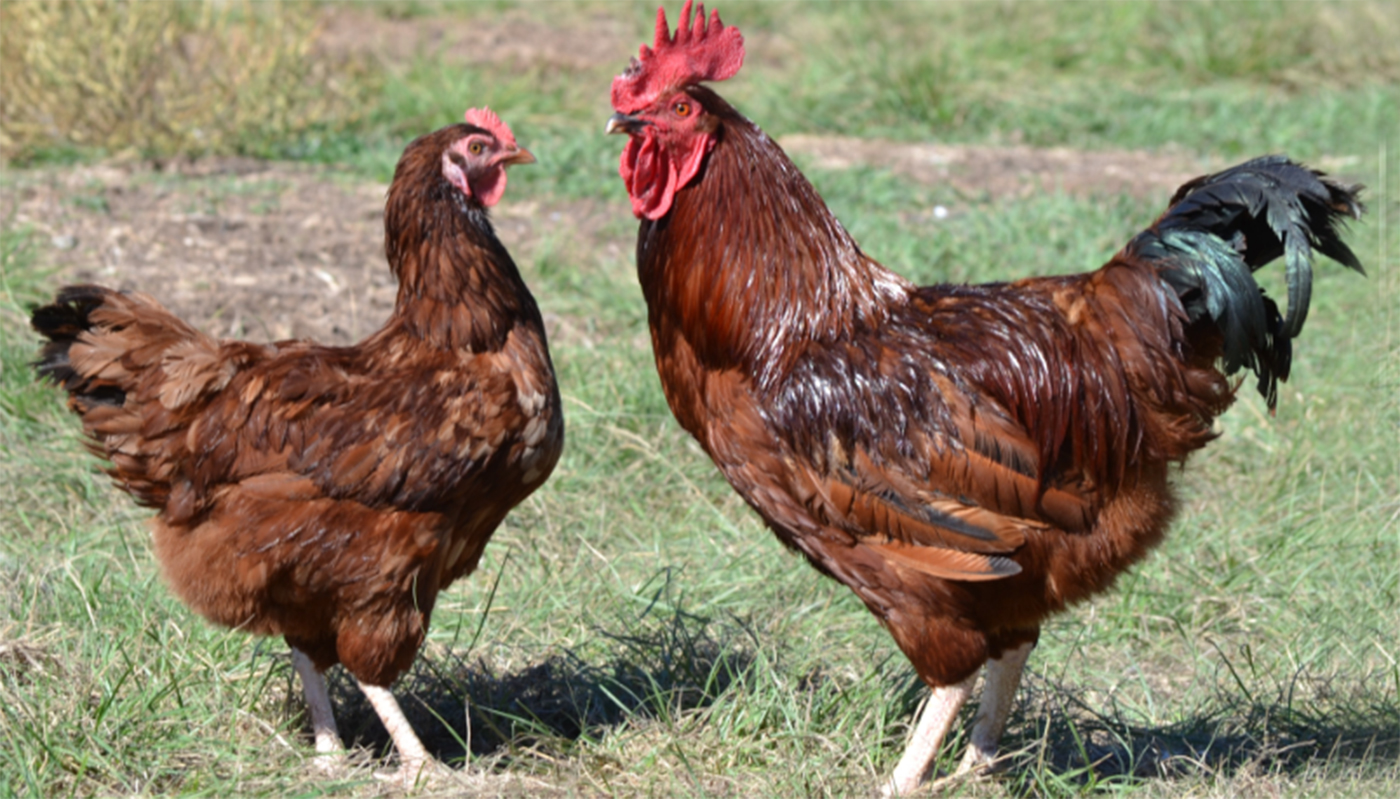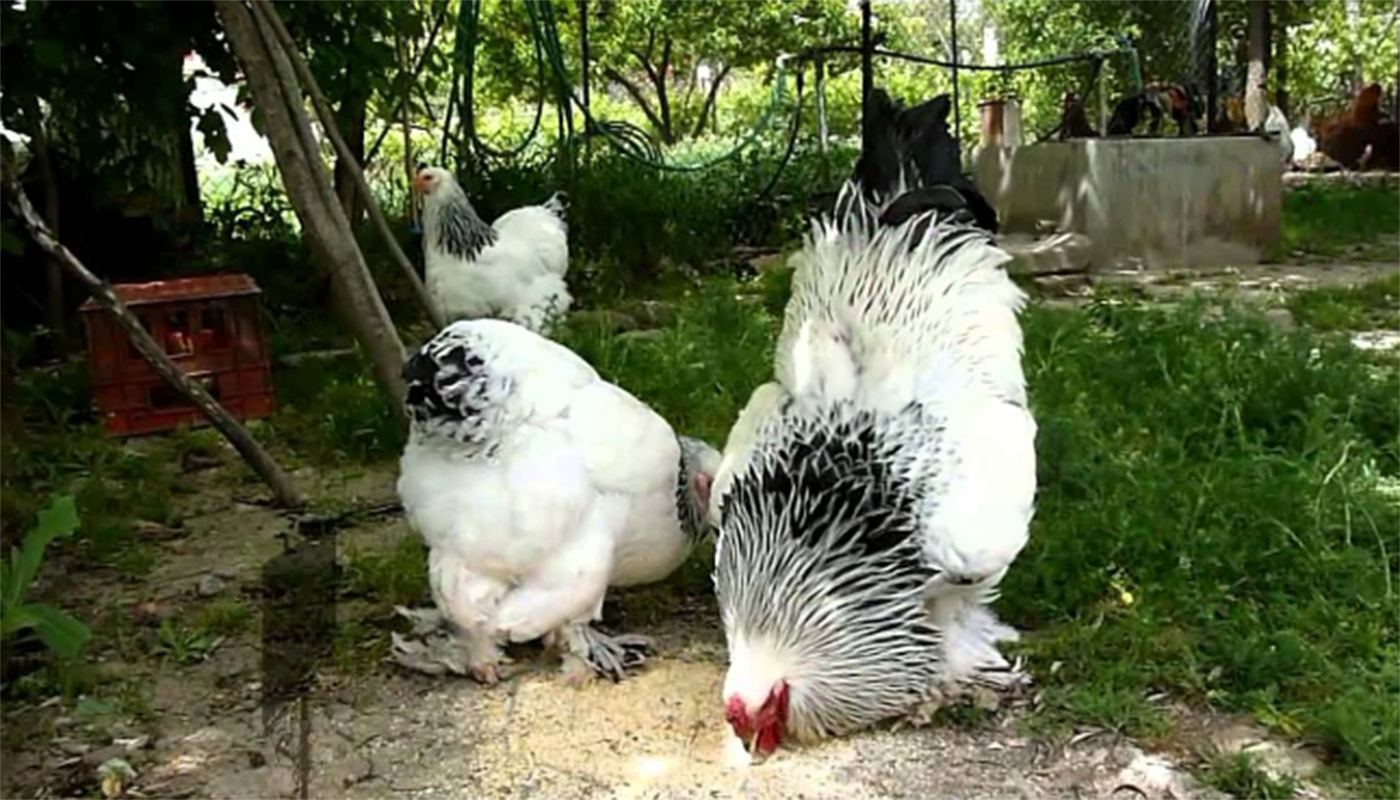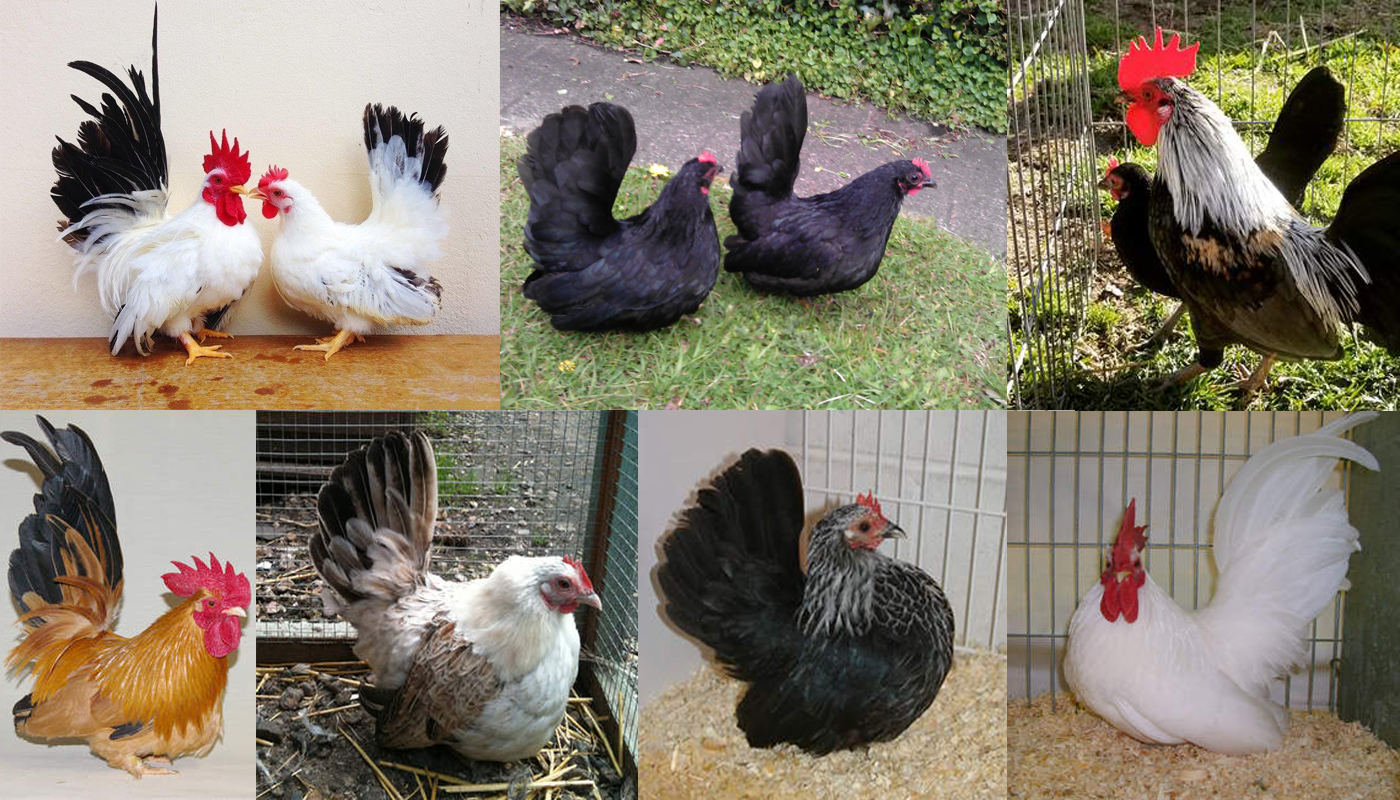
These heavy muscular birds originating from Cornwell in England are the most used chickens in the meat industry. The Cornish Chicken was once known as the Indian Game Hen and are quite an aggressive bird but are not hard to handle. They also need a lot more roam to free range in than other chickens so are not the best breed as a backyard chicken. They do make excellent mothers and will sit their light brown eggs.
| Country of Origin: | England |
| American Poultry Association: | Recognized as a breed of chicken in the United States |
| Chicken Category: | Large Breed |
| Chicken Class: | English |
| Bantam Variety Available? | Yes – All Other Comb Clean Legged Bantam Classification |
| Good Starter Chicken? | Not the best starter chickens |
PURPOSE⇒ |
Eggs: They are not very good egg layers.
They lay large light brown eggs from 106 – 120 per year They do lay all year round. They start to lay eggs from around 16 weeks old.
Meat: They have yellow meat which is tender, and the crossbreeds can be harvested from about 6 weeks.
Breeding: They can be bred and they hens do get broody they are also excellent but very protective mothers but are too active to make good brood hens.
If you are breeding Cornish for show choosing the correct hens and rooster bloodline is crucial.
Foraging: They love to scratch and forage about. These birds need a lot of space to free range about in. The can be confined but the older males start to get stiff legs if they cannot exercise.
Show Bird: There is a show bird category for these chickens.
Pets: They are not hard to handle but are not docile and can be quite aggressive. They are sometimes known as the Bulldogs of chickens.
Other: These chickens can be a bit more cannibalistic than other chickens. Maybe a bit more aggressive than other but are quite easy to handle and quite a calm bird.
|
| Flyers? | They can fly but they are also quite heavy birds so tend not to |
| Noisy Birds? | They can be noisy and lively |
| Interaction with other chickens: | It depends on the characteristics of the breed as these birds were originally bred to be fighting birds. As with any flock if you are introducing new birds it is best to slowly socialize them with the flock. |
| Good with kids? | They are quite a calm bird and do not mind being handled but best to treat each chicken individually and keep children supervised around them. |
HISTORY
The Cornish chicken was developed in or around 1820 in England by a Sir Walter Raleigh Gilbert. Sir Gilbert allegedly produced these birds from crossing Black Breasted Red Game and the Red Aseel. He wanted to produce a superior fighting chicken. The bird would have the speed of the English Game with the sheer power of the Aseel. In 1886 any English Game cross with that of a Malay chicken was to be referred to as “Indian Game”.
Although he failed to create the perfect fighter chicken he did create a unique bird in that both the male and female type are identical.
When viewed from the side the chickens make a heart shape with the muscular body being a lot heavier than its tight-knit fine feathers make it look.
These birds could not withstand the cold weather in America, their egg laying is poor, and they have huge appetites for such slow-growing birds.
The Cornish were found to be good meat birds in that birds could be harvested early and made great 1 lb tender tasty meat birds. They were also found to be excellent to cross-breed with the white Plymouth Rock to create the most commercially used meat chicken in the USA. The Corn/Rock broiler which can be harvested as early as 6 weeks.
The Dark Cornish chicken variety was accepted into the Standard of Perfection by the American Poultry Association in 1898. The White variety was accepted in 1898, the White Lace Red variety in 1909, the Buff variety in 1938 and there is a Black variety that has never been accepted into the Standard of Perfection.
When the Cornish chicken was first accepted by the APA it was called the Indian Game. The name was changed to Cornish Indian Game and the White variety called the White Indian Game. This name was said to be holding the interest in this chicken at bay due to the fact that most people associated game chickens to cockfighting. In 1910 the American Poultry Association (APA) decided the name was to be changed to Cornish and the class of the chicken was moved from Oriental to English. Thus the bird was named for the town and country in which the chicken originated.
CHARACTERISTICS |
|
|---|---|
IDENTIFICATION⇒ |
Appearance/Body: The Cornish is a very close feathered bird and its feather are quite thin, short and narrow.
These birds are muscular birds with their silhouette giving a heart shape appearance. Their legs are bright yellow thick and short. They have broad skulls and a grumpy looking expression. Their tail feathers are held almost perpendicular to their bodies and their faces have yellow beaks with small pinkish earlobes and wattles.
Color(s) Dark, White and White Laced Red
Comb: They have a pea comb
Ave. Weight: Pullet/Hen 2.2 – 5.7 lbs.
Cockerel/Rooster 2.2 – 10 lbs. |
| Life Expectancy: | The average lifespan is 5 – 6 years (some have a shorter lifespan) |
| Health: | They have no known health issues except for frostbite in extreme cold and they need extra protection in the cold. |
| You may Also Like: | HOW TO TELL IS A CHICKEN IS SICK |
| Temperament: | Calm birds that do not mind being handled but can be aggressive. |
| Socialize Behavior? | They do not mind other breeds or animals |
| You may Also Like: | HOW TO SOCIALIZING YOUR NEW CHICKENS |
| Known predators: | Most domestic animals leave them alone as they are large birds, but it is always best to keep an eye on dogs and cats. If hawks and or foxes are in your area it is always best to take precautions. Although they are not an easy target for most feathery predators. Check with local animal shelters, zoos, vets, animal control and or pet stores about common predators in your area. |
| Conservation Status: | These birds conservation status is recorded as “watch”. It is best to check on any special license or instructions that may be set up for owning these birds. This can be checked with your local or national conservation centers. |
IDEAL ENVIRONMENT |
|
|---|---|
| Garden Size: | They need a lot of room to move so are more for the larger to farm sized gardens. |
| Ideal Climate: | They are not very winter hardy birds and need extra care in extremely cold conditions. They do take summers quite well. |
| Ideal Coop: | The rule of thumb for any coop is 50 cm x 50 cm per hen/rooster in the coop. Ensure there is a good space for the nesting boxes and nightly roosting rails at least 1.5 inches wide. Good ventilation for air but not too drafty especially in winter. It is always a good idea to raise the coop off the ground to give the birds a dry place to roost and lay especially in wet weather. |
| Ideal Coop Run: | Cornish are big chickens and they do not tend to fly but they can. It is necessary to fully cover the coop run it is always advisable in order to give the birds a safe secure environment. |
| Ideal Flock Size: | They are quite happy in any size flock as long as they have one companion to wander the gardens with. |
| Special Instructions: | Their feathers need extra care in the winter or extreme cold. |
| Accessories: | The following accessories are ideal for your coop: Nesting boxes Straw for the boxes and roosting area Roosting rails Perches Water troughs/bowls Food bowls/feeders Heating lamp(s) Animal carrier for transport purposes |
| You may Also Like: | 45 FREE DIY CHICKEN COOP PLANS, TUTORIALS AND DESIGNS |
WHERE TO FIND THESE BIRDS TO ADD TO YOUR FLOCK
Cornish can be found at most live poultry outlets and farms, it is best to check with your local conservation centers and registered breeders. You can find registered breeders on the American Poultry Association website along with a host of valuable information. They will also be able to help with any special requirements, attention or care they may need. If you plan on breeding your chickens, you will want to make sure that they are from a good bloodline.
CARING FOR THE BIRD(S)
Please click here for our full guide to “Taking care of chickens”. This is a comprehensive guide to owning chickens. It covers where to start from choosing your ideal flock, the coop that would best suit your garden, your bird and you to buying and bringing your bird(s) home.
GENERAL
They are generally calm birds although they can be aggressive and lively. They do like to stretch their short legs a lot so make sure they have enough freedom and space to move around.
GROOMING
Other than a dust bath with maybe some added herbal essences mixed into the loose sand to help with pests and excess feather oils Cornish have no special grooming requirements. But they are extremely susceptible to mites, lice and various other parasites. Checking for these pests in their feathers should be done at least once a week to your chickens healthy. Always get your birds de-wormed on a regular basis especially if they are around other animals or interacting with kids.
DIET AND NUTRITION
These birds are very hungry chickens so will need a well-balanced diet of chicken pellets, grains, chicken mash or grain mix from 8 weeks old and older. This should be fed to them first thing in the morning before they are let out to roam about to ensure they are getting all their nutrients.
For baby chickens, the best is always Chick Starter when they are under 8 weeks old.
Laying hens should get extra protein and calcium in their diets to ensure the quality of their eggs and to keep them in tip-top health.
Cornish do love getting table scraps in the form of vegetables and fruit. They find these scraps even better if they are served as ice-cubes on very hot days.
Feeding your chickens correctly will give your organic garden a lot of nutritious fertilizer to make your vegetables or flowers grow.
Please see our comprehensive guide to “Feeding your chickens” for more information of the different types of chicken feed for chicks, hens, laying hens, roosters, etc. and where to buy the feed and approximate cost of the feed.
SOCIALIZING THE BIRD(S)
Cornish do tend to drop in the pecking order and even though they can be aggressive they tend to back down from more aggressive birds. However, they were bred to fight so the instinct is still there, so it is best to always check on how well a breed will get on with your current flock before buying them as you do not want to upset your coop or stress your current flock.
If you want to introduce another breed with your Cornish, try a breed that has a gentle calm diplomatic nature that will keep the aggressive side of the Cornish at bay.
As with any newcomer to the roost, you will have to quarantine the bird for 7 – 31 days to ensure it does not have any unwanted critters or disease that could spread to your current flock.
Even though they tend to be lower on the pecking order, they still do have a pecking order, so it is advisable to socialize them slowly and determine when it is right to allow the newcomer(s) to become a permanent part of the flock.
NOTES / SPECIAL INSTRUCTIONS
As they are registered as a “watch” conservation status they may need an extra license to own or keep in your garden. For advice on what the bird’s conservation status and orders are please check with your local conservation department.
For breeders, it is imperative that you always check your bird’s bloodlines and ensure you are buying your birds from a reputed breeder/farm. In order to sell birds of such stature, they have to be recorded and documented, always check with local animal breeding organizations for these records.
These legitimate documents are also required should you wish to show your bird(s) in various poultry shows/competition showings.
For information and advice on adopting rescued animals, you can visit or contact your local animal welfare center.
USEFUL LINKS
- Caring for your Chicken
- Feeding
- Health
- Socializing your Chicken
- Breeding Chicken
- Raising Chickens A-Z
- Hatching Eggs
- What is Molting
- Animal Shelter (ASPCA)
- American Veterinary Medical Association
- American Poultry Association
- American Animal Welfare Society
- American Animal Control
- American Animal Husbandry Society
References
- https://en.wikipedia.org
- https://livestockconservancy.org
- https://www.roysfarm.com
- https://www.mypetchicken.com
- https://www.backyardchickens.com
- https://www.feathersite.com/
 Yokohama Chicken Breed – Everything You Need to Know
Yokohama Chicken Breed – Everything You Need to Know Dominique Chicken Breed – Everything You Need to Know
Dominique Chicken Breed – Everything You Need to Know Top 10 Trending Chicken Breeds of 2024: Feathers, Eggs, and Personality
Top 10 Trending Chicken Breeds of 2024: Feathers, Eggs, and Personality Silkie Chicken Breed – Everything You Need to Know
Silkie Chicken Breed – Everything You Need to Know All about Pullets, Hens and Eggs
All about Pullets, Hens and Eggs Feeding your Chickens
Feeding your Chickens Frizzle Chicken Breed – Everything You Need to Know
Frizzle Chicken Breed – Everything You Need to Know Orloff Chicken Breed – Everything You Need to Know
Orloff Chicken Breed – Everything You Need to Know Rhode Island White Chicken Breed – Everything You Need to Know
Rhode Island White Chicken Breed – Everything You Need to Know 10 Chicken Breeds that do well among other Chicken Breeds for a Mixed Flock
10 Chicken Breeds that do well among other Chicken Breeds for a Mixed Flock Campine Chicken Breed – Everything You Need to Know
Campine Chicken Breed – Everything You Need to Know Japanese Bantam Chicken Breed – Everything You Need to Know
Japanese Bantam Chicken Breed – Everything You Need to Know